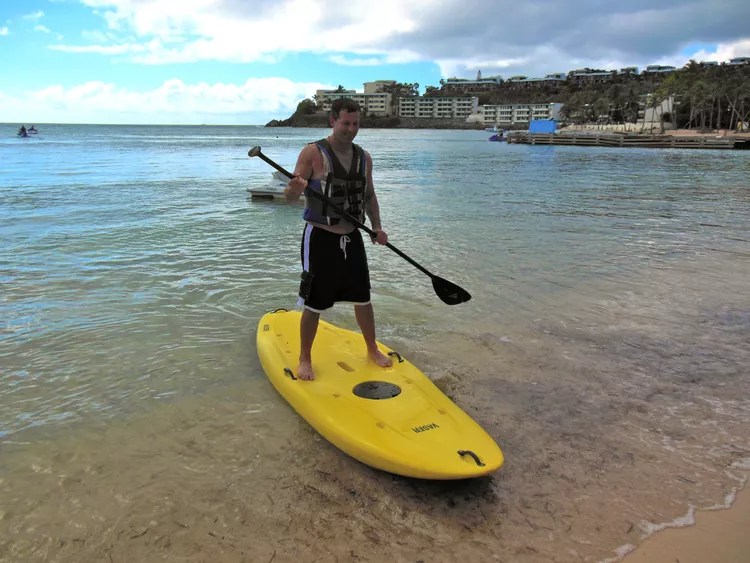Article Summary
Learning to Standup Paddleboard: Feet Wide, Eyes Forward
If you’ve ever seen someone casually steering a stand-up paddleboard (SUP) down a local river or across a tranquil bay, your first instinct might be to think: that looks easy. I suppose relative to its close cousin, surfing, it is. However, no matter how you slice it, standing up on a platform on the water isn’t always a breeze, as anyone who has ever fallen off a floating dock can attest.
Moreover, a standup paddleboard is significantly smaller than a dock. On land, it at least looks pretty big—your average SUP board is 9 to 12 feet long and up to 3 feet wide, making it comparable to a traditional longboard for surfing (although modern longboards typically top out at around 10 feet). Like surfing, standup paddleboarding has its roots in Hawaii.
The other major piece of equipment you’ll need is the paddle, of course, which should be adjusted to your standing height to allow you to propel and turn the board effectively. Additionally, wearing a personal flotation device (PFD), a.k.a. a life jacket, is essential.
The need for the latter becomes apparent as I set off from the Bolongo Bay Beach Resort in St. Thomas, U.S.V.I. for my first attempt at standup paddleboarding. My instructors, Dave Tracy and Yoshi Tochiki, offered crucial tips, primarily: hold the paddle with two hands, one on top and one on the shaft for the best leverage; and stand in the middle of the board with your feet shoulder-width apart and aligned with your shoulders. (Of course, starting out on your knees until you build confidence is perfectly fine.)
Seems simple enough, I reassure myself. In truth, I did pretty well as I made my way into the calm bay, paddling slowly but steadily. This sport is not built for speed—zen-like relaxation is more the goal. Standing offers a great view of the surroundings.
Which brings up another good pointer—keep your head up and your eyes fixed ahead, despite the temptation to look down at your feet. “Keep your knees bent, your eyes forward, and paddle like you mean it,” says Kendall Cornejo, who manages the watersports shack at Cinnamon Bay on nearby St. John.
You can’t get too relaxed, however. As soon as a few ripples come along—even those not worthy of being called “waves”—you’ll discover that to remain upright, you need to continuously make small but critical balance adjustments in your legs and core. Consequently, the bumpier the ride, the more you find yourself engaging little muscles all over your lower body—this sport indeed provides a good workout!
Inevitably, I ventured a bit too far out, where the waves began to resemble actual waves. Into the surf, I tumbled, fortunately avoiding the board itself and bobbing back to the surface close to my paddle. Remounting the board is pretty easy, but I don’t need added encouragement from Dave and Yoshi to steer back to calmer waters.
Paddleboarding: You WILL Stand Up the First Day!
Once you get the hang of it, standup paddleboarding is a lot of fun. You can leisurely skim the water’s surface while taking in the beautiful Caribbean landscape, peer down to spot fish and turtles, and even briefly take a hand off the paddle to wave at passing boaters.
The learning curve isn’t too steep—a 15-minute lesson and 15 minutes on the water should boost your confidence. Unlike the experiences many have with surfing, you’re almost certain to be standing on the board your first day. Of course, this is a sport where you can progress to tackle real waves like a surfer, which obviously requires much more practice. For beginners, possessing decent balance and some core strength aids significantly—therefore, consider doing a few sit-ups before heading down to the islands!
Check Bolongo Bay Rates and Reviews at TripAdvisor





